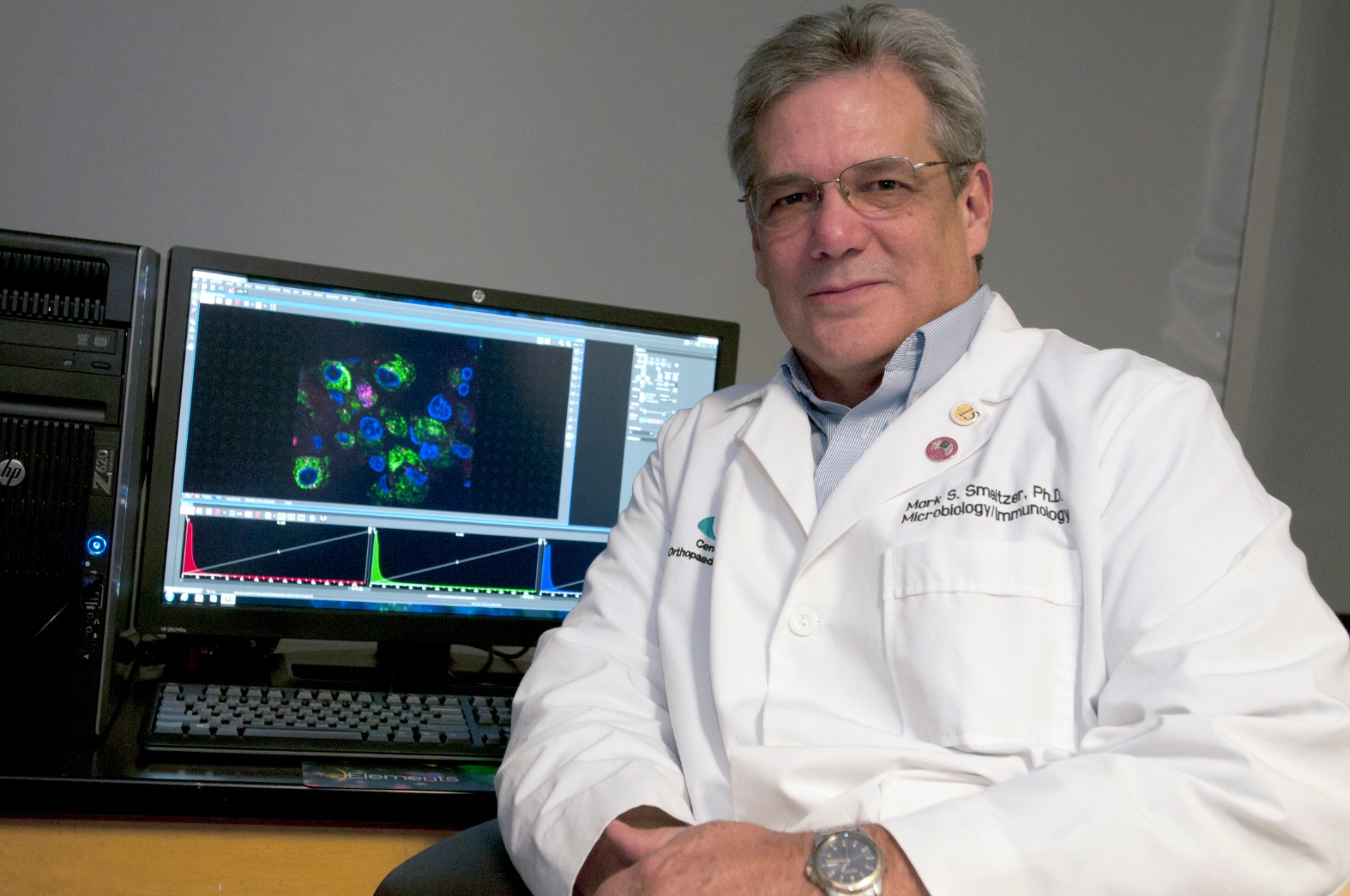View Larger Image

Mark Smeltzer, Ph.D.
Image by Johnpaul Jones
Infection Expert Part of $5.6 Million Grant for Bone Regeneration Technology
| UAMS researcher Mark Smeltzer, Ph.D., is applying his expertise in bone disease and infection to a $5.6 million project for the U.S. Department of Defense (DOD) aimed at making the technology to re-grow bone available for the military and the public.
The grant was awarded to Alex Biris, Ph.D., chief scientist at the Center for Integrative Nanotechnology Sciences at the University of Arkansas at Little Rock. Biris serves as principal investigator, with collaborators Smeltzer and David Anderson, Ph.D., of the University of Tennessee, Knoxville.
The interdisciplinary team will work to advance the NuCress™ scaffold, a groundbreaking bone regeneration technology. Such a device is in high demand by a wide variety of people, including wounded soldiers, victims of major accidents and trauma, and patients with bone disease.
Smeltzer is an internationally recognized expert in infection, especially Staphylococcus aureus, commonly known as “staph,” and osteomyelitis, or infection in the bone. He is a professor in the Department of Microbiology & Immunology and the Department of Orthopaedic Surgery in the College of Medicine and holds the endowed Chair in Sciences Basic to Medicine at UAMS.
“Infection is a dreaded complication of traumatic bone injury, and the ability to incorporate antibiotics into the NuCress™ scaffold offers the tremendous added benefit of preventing infection in a contaminated bone defect without compromising its bone regenerative properties,” Smeltzer said.
Biris and Anderson have worked together since 2006 to develop this pioneering medical device. The NuCress™ scaffold is in the final stages of moving from the laboratory to the surgical theater, with potential future uses in both military and civilian hospitals. The new award from the DOD’s Joint Warfighter Medical Research Program will help facilitate this transition by funding critical go-to-market research.
“I’m thrilled to see over a decade of collaborative work result in this continued DOD support, and I look forward to seeing it develop into a clinically beneficial product,” Biris said.
The NuCress™ scaffold is an implantable device that promotes controlled, robust bone regeneration in fractures, gaps where bone is missing, and major injury defects, including previously untreatable catastrophic injuries. The “scaffold” provides a structure on which the bone can grow. The device degrades as the bone grows, potentially eliminating the need for multiple surgeries — a major source of complications in current bone gap treatments.
“The NuCress™ scaffold is a game-changing technology that will revolutionize treatment of bone diseases because it is capable of simultaneously promoting bone regeneration and delivering antibiotics, growth factors and cell-based therapies,” Anderson said.
U.S. Sen. John Boozman, who supported the UA Little Rock proposal to the DOD and was instrumental in securing federal funding for the project’s earlier research, congratulated the team on the award.
“Bone regeneration technology is so important to the recovery of our warfighters from severe injuries,” Boozman said. “UA Little Rock and its partners have made tremendous progress taking this novel nanotechnology solution from the laboratory to the point of clinical trials.”
Studies funded by past DOD awards proved the scaffold’s versatility and ability to regenerate large, missing segments of bone. The new, four-year DOD award will support pre-market work, including manufacturing and U.S. Food and Drug Administration clearance. If successful, the project will allow the scaffold to move toward clinical trials, validate its utility for clinicians, and develop a new market application for treating infection.
“Efforts like these are vitally important because they keep scientific discoveries from languishing in the lab, and instead, make them available for the public,” said Shuk-Mei Ho, Ph.D., vice chancellor for research at UAMS. “We’re excited by the promise of Dr. Biris’ and Dr. Anderson’s work, and proud that Dr. Smeltzer’s expertise will help move the project to the next stage.”